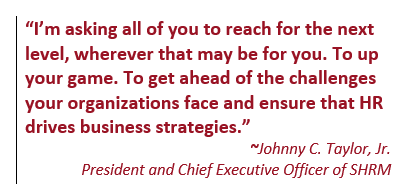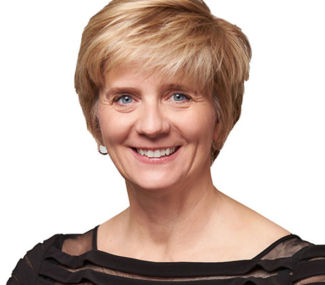It’s Change or Lose for Human Resource Executives


In a crowded conference hall of human resource professionals, the first address of the North Carolina Society for Human Resource Management (SHRM) annual conference was high energy, comical at times, and clear in message. The human resource executive needs to “up his or her game” to meet the most demanding challenge today’s organizations are facing – the demand for human talent.
As a guest speaker at the conference, I had the opportunity to be in the hall. Listening to the powerful message delivered by Johnny C. Taylor, Jr. President and Chief Executive Officer of SHRM, I was excited and encouraged. His message dovetailed nicely to the one I would give later that day; HR must lead the shift in mindset to a human-centric organization.

He reassured SHRM members that his challenge does not minimize the hard work and passion that have gotten them where they are today. Rather, the call is to maximize their capacity to improve what HR professionals do and how they do it. It means stretching. Possibly failing at times but never losing the courage to push and learn. His call to action was that “HR professionals must elevate themselves as the experts on all things work and a source of solutions to the people challenges facing the future of business.”
A Timeline of Executive Evolution
An effective C-suite requires a talented team. Throughout history, periods of change have offered opportunities for different types of functional leaders to wield greater influence. Along the way, these leaders have wrestled to understand the changes occurring and the action needed to lead successful transformation.
The 1980s
The CIO held considerable influence over the strategic direction of an organization, determining which technologies would be implemented to ensure a leaner, faster, more process compliant organization. Even if an organization looked and felt the same to its customers, CIOs were change-agents internally, transforming their companies to prepare for the disruption the internet would bring.
The 1990s
The dot-com boom of the late 1990s ushered in the CTO era. CTOs stole a lot of thunder from CIOs, who by now were bogged down with legacy systems to maintain in order to keep the lights on and processes running efficiently. IT had maxed out its ability to maximize profits, so attention turned to how technology could be used externally to feed the bottom line by improving or overhauling a company’s product or service offerings. The CTO gladly took on that task.
2000s
Again, things changed. Before long, the CMO became the darling of the C-suite, with primary responsibility for monetizing the new technologies, products, and services that the CTO developed. Advances in data analytics and data science and automation have changed the CMO role considerably in recent years, by expanding it to encompass functions like customer experience and engagement.
Today
Things are changing again. It’s HR’s time to take the reins. No one is better positioned to lead the transformation to a human-centric organization. To succeed, HR professionals have to do the work to understand what’s driving change, how it will affect human behavior, and how it will affect their companies, customers, industries, and their own function going forward.
The changes happening today point to why it is so critical for HR to lead the transformation to a more human-centric organization. Organizations that fail to organize around the distinct skills and values of their people risk their future relevance and success. Organizations that succeed in doing so are better positioned to achieve resilience through four fundamental changes.
From Conformity to Choice
Just as we have come to expect personalization in our retail experiences, we want and expect a tailored professional and work engagement. Members of the workforce are highly reticent to be forced into a role. For organizations to get the talent and experience they need, they must redefine processes, structure, and governance to allow for a customized experience. A starting point is considering where you can customize benefits, job descriptions, training, and work schedules. There will be challenges, such as fostering an inclusive culture that speaks to each employee’s uniqueness and value. Even when difficult, conversations about the merits of choice over standardization and compliance indicate that the organization is moving in the right direction.
State of Flow
Companies have always operated in a state of continuous flow. Today’s organizations need more significant ability to react and adapt in an era of constant disruptive change. Gone are the days of hire and fire. Access to talent is getting more and more competitive. HR has an opportunity to develop organizational processes and policies that take the “long view” of working relationships. Access to the right talent at the right time and the right place for the right purpose means taking a very different approach to creating a dynamic state of flow. HR leaders must maintain talent and expertise “on the bench” so they can engage them as needed. The new relationship resources include innovative contracting, robust use workforce databases, and relationships with suppliers and partners.
Silos to Spheres
Valuing the full sphere of a person’s capabilities and thinking in inclusiveness instead of silos will increase the innovation mindset and competitive fiber of a company. It may help to think of talent as elements in a human portfolio. The assets are the full spectrum of uniquely human attributes, including creativity, curiosity, passion, persistence, diplomacy, courage, empathy, and enthusiasm. Balancing the portfolio of traits, personalities and intelligences is key to achieving strategic success for a company.
Overcoming Obsolete Knowledge
We all carry outdated ideas and paradigms that no longer serve us. Many of the beliefs, cultural norms, and processes that worked so well in decades past have lost relevance. Retaining them gets in the way of speed, agility, and effectiveness. Job number one is to actively spot outmoded practices, processes, beliefs, and behaviors. This task is deeply behavioral. HR must advocate for getting rid of the platforms that are no longer useful to make space for more relevant human-centric initiatives. They need to become bias busters who challenge belief systems and genuinely seek to understand those of others. They must focus on growing more aware of their own– and others’ – unconscious biases in the effort to break patterns and change behavior.
To succeed as a company of the future, organizations must embrace a human-centric approach. As was so clear at the SHRM conference, HR is the beacon for that transformation. We’re in the midst of an organizational revolution. As businesses and government entities face complex issues on every level from technical to geopolitical, leaders across the C-suite can have confidence in an organization optimized around the distinct skills and intellects of a highly connected, profoundly convicted workforce.
{{cta(’15a7210e-ed4b-4b0e-93ae-5ecae780cc93′)}}
- Categories
- Leadership
- Workforce of the Future

 About the Authors
About the Authors